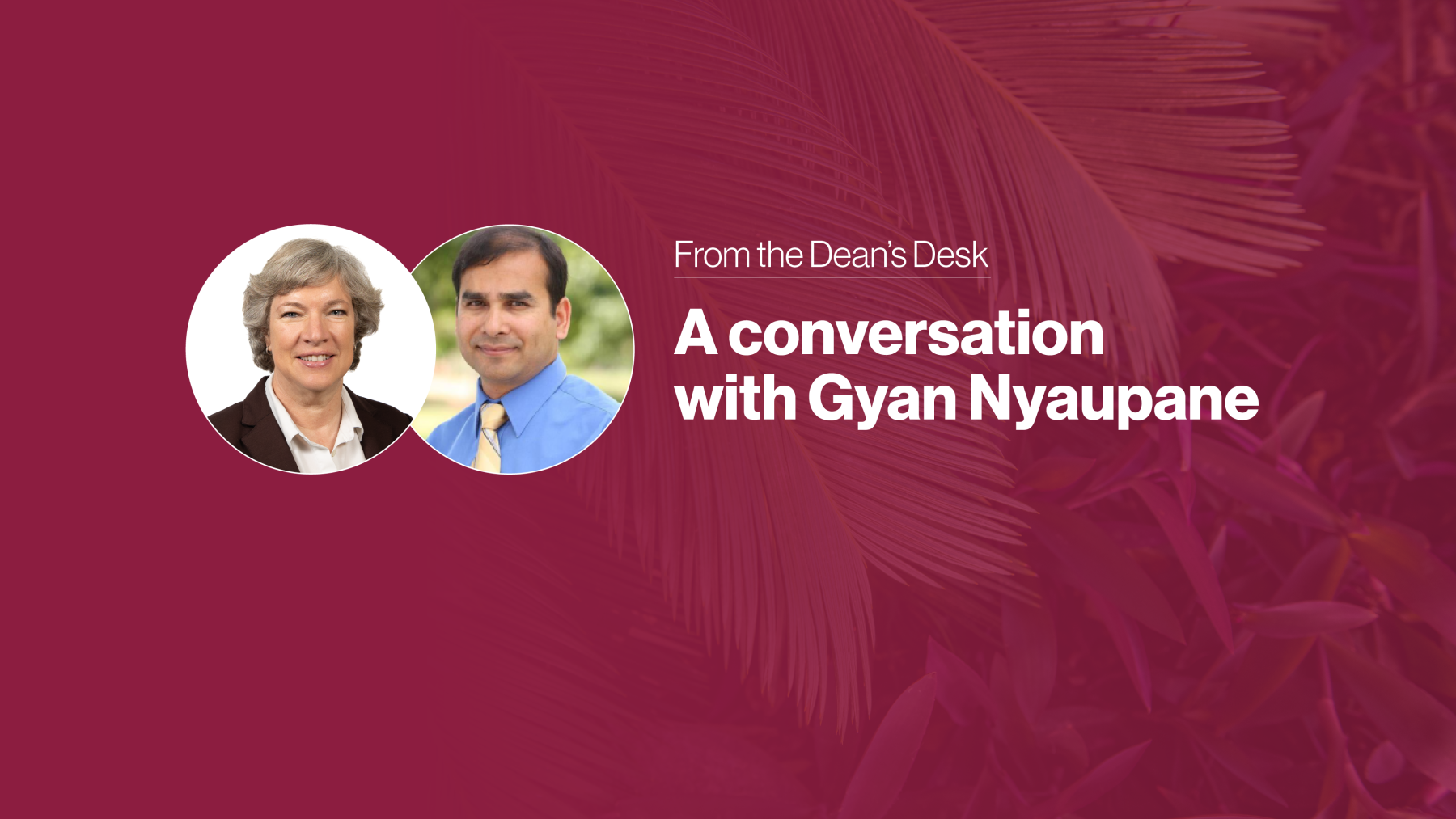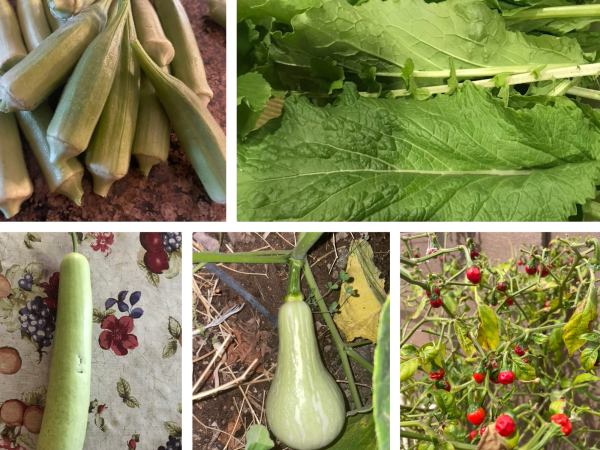
Tend to what you wish to grow: Gardening 101 with the Graduate College’s Dean’s Fellow
It is my pleasure to share this issue of the Dean’s Desk with my colleague, ASU professor Gyan Nyaupane. Dr. Nyaupane is a Faculty Fellow at the Graduate College for the academic year 2023-24. A Faculty Fellow is a year-long leadership position in which the fellow undertakes a project that advances graduate education. Dr. Nyaupane, once an international graduate student, has decided to learn more about how we serve international students and how we might create new opportunities. In talking with Dr. Nyaupane, we started to talk about food from his home country and how he now gardens! He even shared some onion sprouts for me to grow in my garden. I look forward to you reading our conversation.
-- Dean Wentz, Vice Provost and Dean, Graduate College
Please tell us a little about you, how you got to ASU, and your work here.
My name is Gyan Nyaupane. I am a professor in the School of Community Resources and Development at the Watts College of Public Service and Community Solutions. I have held various leadership roles over my 20-year tenure at Arizona State University, including graduate program director and associate dean. My study and work have taken me to all continents except Antarctica, where I have collaborated with diverse groups of students and researchers.
I joined ASU in the fall of 2004, arriving in the scorching Arizona summer with my wife and two young children, who are now proud Sun Devils. I was thrilled to embark on my academic career as a faculty member. I was deeply inspired by ASU's transformation of the New American University. As a first-generation college student, the university's commitment to inclusivity resonated with me.
My research interests center around human-environment interactions, particularly in public land management, sustainable development, and tourism. I regularly teach graduate and undergraduate courses on sustainable communities, critical community development issues, sustainable tourism and tourism planning.
Some of my recent research projects include ecological restoration and economic development along the US-Mexico border, the research to inform a state-wide comprehensive public lands and outdoor recreation plan for Arizona, the evolving relationship between Indigenous Peoples and their land and resources and the role of tourism in conservation and poverty alleviation.
I know your Faculty Fellow position will focus on international students, so can you share your experience as an international graduate student?
I am incredibly fortunate to have earned degrees on three different continents. As a former international student in the United States and New Zealand, I had the unique opportunity to immerse myself in diverse cultures and collaborate with various students and scholars from different cultural backgrounds. The learning curve steepens when you find yourself in a new country, navigating unfamiliar education systems, cultures and cuisine. While many aspects of adjustment can be gradual, the need for food is immediate. Upon arrival, you start thinking about what and where to eat and where to find familiar foods. I vividly recall the hours spent searching various stores for specific ingredients and the physical and mental challenges of acclimating to new cuisines and discovering new tastes. I also began to value the richness of different perspectives and cultural backgrounds that influence dietary restrictions and variations in eating habits.
We talked about the cultural importance of food; can you tell us how food plays a role in your life.
Food plays a vital role in culture, and the flavors, memories, and stories of culinary experience stay with you indefinitely. Certain dishes and culinary traditions are intertwined with festivals and holidays, forming deep-rooted connections as we grow up. I spent my childhood in rural Nepal on a farm without road access or electricity, meaning no imported food and refrigeration. We had to cultivate everything we required, from rice and wheat to corn, mustard for cooking oil, lentils, vegetables, fruits, herbs and spices. Additionally, we raised chickens and goats for meat, while cows and water buffalo for milk and butter.
My fundamental lessons on sustainability, planning, systems thinking, and wellness originated from our approach to food- how it was cultivated, stored, consumed, and repurposed. For example, within our farming system, nothing went to waste; animals consumed all food residues, animal dung was used for making biogas for cooking and lighting, and the biogas slurry was returned to the fields as fertilizer. I can’t think of a more sustainable lifestyle.
So to help you with your own cuisine, you garden! Can you tell us about gardening in the desert and how you personally grow food in desert conditions? What tips do you have?
I feel so fortunate to have been exposed to farming with invaluable life experiences and knowledge in farming and agriculture. Farming is a multifaceted system, requiring expertise in diverse fields such as soil chemistry, hydrology, microbiology, animal breeding, genetics, entomology, statistics, engineering, meteorology, and their interactions. This shows the importance of interdisciplinarity in understanding the socio-ecological system for our livelihood. I had the opportunity to reinforce this knowledge during my college years, where I pursued a major in forestry and ecology and, later, in social sciences in graduate school. As a gardener, I had the chance to apply some of this knowledge in real life.
Whenever I visit a new place, I think about people’s connection with the land and its socioecology – what the natural environment offers and what people cultivate to sustain themselves. Before moving to Arizona, my experience with the desert environments was limited. When I purchased my first house in Tempe, I began to explore and experiment with growing vegetables in my backyard. I consulted colleagues interested in gardening and learned about their practices. I also studied online resources and found the Vegetable Planting Calendar for Maricopa County very useful. This is an excellent resource for local gardening enthusiasts. This calendar offers valuable insights into the planting and harvesting season of various fruits and vegetables suitable for the valley. I realized that there is a concise window for seeding and planting vegetables due to the brief fall and spring seasons and the long summer in the desert. While winters are mild, a few frozen nights can be detrimental to frost-sensitive plants such as chili peppers, eggplants, and tomatoes. It would help if you covered them during nights when the temperature drops below 32 degrees.
Gardening is so much fun. Observing how the seeds you plant germinate, grow, and blossom is fascinating, providing you with produce for your cooking. Gardening not only ensures healthier food but also promotes physical and mental well-being. It gives you a reason to step outside, water plants, weed and harvest the fruits of your labor and nature. Gardening has been my most effective form of mental therapy, and its significance and benefits became even more apparent during COVID when outdoor activities and interactions were limited.
Moreover, gardening is good for the environment. It helps save energy and reduce food waste and the burden on landfills. I create my compost using fruit and vegetable scraps, coffee grounds, eggshells, and dead leaves. It also attracts small birds and butterflies, crucial in pollination.
Gardening is socially rewarding as it fosters connections with family and friends through shared experiences and the exchange of seeds and produce. It also brings back fond memories of my childhood.
What do you grow and how do you use the produce?
I have created several raised beds to grow vegetables. While space is limited, I develop a variety of vegetables based on the seasons. September to April is the ideal season for vegetable gardening in the valley. During this time, I grow lettuce, mustard greens, kale, bok choy, brussels sprouts, arugula, shallots, onions, garlic, coriander, along with carrots, cauliflowers, chili peppers and peas. It is surprising for some that you can grow certain vegetables in summer, although choices are limited. During the summer, I primarily grow okra and eggplants, as they tolerate the heat and thrive well as long as they receive enough water. Due to my limited space and travel, I don’t grow all these crops yearly. I utilize the produce for cooking, and any surplus is shared with friends and colleagues.

More stories from the Graduate Insider

Graduate funding deadlines for Fall

How to feel confident in your next interview
Let’s be honest, interviews can feel nerve-wracking. Your palms sweat, your heart races, and you start to second-guess whether you even remember your own name. But here’s the good news: with a little preparation, you can walk into (or log onto) your next interview feeling calm, collected, and ready to shine.
